I was in the middle of sending this article off to Ian when another article appeared on FishingMagic –Tony Gibson’s excellent piece on the giant bream at Ferry Lagoon.
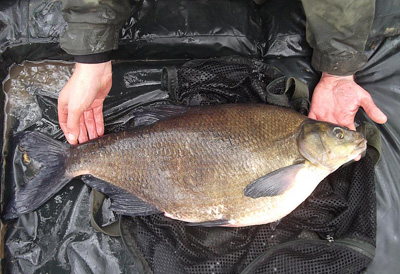 Fishing for 20lb bream is a mind blowing prospect, let alone on a 200 acre inland sea! That is ultra-serious specimen hunting and it must take some truly staggering fortitude to go on blank after blank. I have to say I thoroughly enjoyed Tony’s piece before realising that it left my little article somewhat over shadowed! You see, like many of us, a big bream to me is anything over 8lb and a double is something to be seriously happy about. I cannot even begin to imagine what a twenty would look like let alone how to catch one. So I ended up chopping and changing what I had written, then changing and chopping all over again.
Fishing for 20lb bream is a mind blowing prospect, let alone on a 200 acre inland sea! That is ultra-serious specimen hunting and it must take some truly staggering fortitude to go on blank after blank. I have to say I thoroughly enjoyed Tony’s piece before realising that it left my little article somewhat over shadowed! You see, like many of us, a big bream to me is anything over 8lb and a double is something to be seriously happy about. I cannot even begin to imagine what a twenty would look like let alone how to catch one. So I ended up chopping and changing what I had written, then changing and chopping all over again.
I never intended this to be a ‘how to’ piece, particularly as it started out as a story of a weekend I spent down a lake in Ringwood. But the more I wrote the more I realised how much I needed to explain myself. It’s funny but it was only until I started writing I realised how much thought I actually put into way I fish for bream; it involves a lot more thinking then my more instinctive barbel or chub fishing.
And perhaps that is why I love my spring time bream sessions; they are a perfect antidote after a winter hiking the river banks. Bream fishing for me means more than just being very smelly and covered in bait and it takes a fair amount of prior planning before you can get to the happily smelly stage. In hindsight perhaps I should have called this article: Specimen Bream Fishing – What Mad Men do in the Close Season as it is most definitely on the lunatic fringe of my fishing.
The thing is some anglers appear to have a pathological hatred of all things bream and this aversion remains – even towards the really large ones. I dread to think how many huge bream have been returned without weighing because “It ain’t a carp, mate!”, yet in specimen terms these are some of the biggest fish these chaps are ever likely to catch.
Most big bream fishing is something every angler can easily turn their hand to. You tend not to need an expensive syndicate as finding a venue with a good head of bigger slabs is fairly easy nowadays – your average gravel pit is perfect. Add to that the fact that you do not need to be able to cast 200 yards, have particularly specialist gear or even be that skilful. With basic fishing skills, tackle and a bit of forethought almost anyone can go out and catch a proper dustbin lid.
Location and Time
Undoubtedly the best time to fish for bream is April and May and by this time they should be fully awake and ready to feed hard. If they have yet to spawn it will also mean that females are at their biggest weight as well as being shoaled up ready for rumpy pumpy.
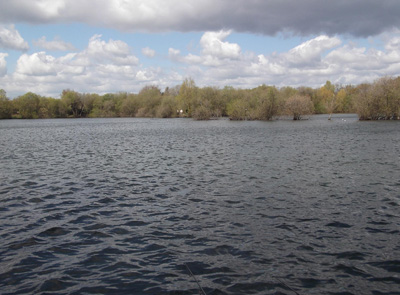 Location really depends on the lake you are fishing, there will always be going swims but a trick I look out for is how much water your swim commands. If you are after big bream there is little point in fishing close to the snags in a confined jungle swim – leave them to the carp boys. Big bream tend to stick to the wide open spaces, so your swim should command as much water as possible. Points and spits that stick out into the middle of the lake are ideal.
Location really depends on the lake you are fishing, there will always be going swims but a trick I look out for is how much water your swim commands. If you are after big bream there is little point in fishing close to the snags in a confined jungle swim – leave them to the carp boys. Big bream tend to stick to the wide open spaces, so your swim should command as much water as possible. Points and spits that stick out into the middle of the lake are ideal.
Once you have found an area that commands a serious amount of water use a marker float and find yourself a feature and as long as that feature is a good distance from the bank, say 40 yards or more, then it is almost certainly going to be visited by the bream at some point. In particular bream seem to love the rough ground of bars or any place where the water gets slightly shallower. My theory is that the shoal uses these as ‘roads’ or points of direction and fish can be caught on the top of the feature or at the bottom of it, so it’s worth covering both.
The lakes I have fished for big bream are invariably night waters and, although they do sometimes feed during the day, for the most part the big fish are nocturnal and that, unfortunately, means living in a bivvy drinking tea for a few days – such a hard life!
Make sure you are ready for the last hour or so of light; your feed should go in about tea time to give it enough time to draw the fish in without dropping it on their heads. Spod rod, spare rigs, unhooking mats, nets and your groundbait buckets need to be close to hand – everything in place and ready to rock and watch the water in front of you for rolling fish but do not be put off if they are not rolling right on your bait. They do move about quite a bit and any rolling fish is a sign that they will feed soon. Of course if they are rolling in front of you, get ready for a busy night!
Bait (Or more to the point, groundbait)
When I say you may need a lot, I am not kidding. Bream have big appetites and what you are trying to achieve is a bed big enough to hold the shoal for quite a while.
Buying one pack of groundbait from the tackle shop is just not going to help you and I reckon I’ll use about 3 to 5kg of dry mix per night, possibly more. If I am doing a three night session then that is as much as 15kg! When you start to look at how much that will cost you if you were to buy it readymade, then at £4 a pack it’s going to add up. Because I have Scottish blood flowing in my ancestral veins I simply cannot even consider spending that amount and that is why I head down to the local farm shop.
I base my groundbait on Vitalin (dog porridge basically) and pigeon conditioner (a seed mix not a shampoo for birds). All of which is put through a blender after which I add any old mini pellets I have kicking about. I think this is fairly standard fair nowadays but what makes mine a little different is the fact I put in some roughly ground dog biscuit to create some particles that float. These floating particles really make the groundbait fizz and explode underwater, spreading it about more evenly. The added bonus of this is that it creates a scent trail right through the water column. It worked like a dream when I first tried it, just drop some in the margins and watch what happens!
I mix in various attractors like molasses at home as well and also use a shop bought groundbait for a bit of extra colour and attraction with 1kg for every 4kg of bulk mix more than enough. I use Expo from Van Den Eyde, for me no other smell reminds me of fishing more and fish love it too. Then, when I mix in the water on the bank, I throw in a few hookbait samples, more pellets, sweetcorn and condensed milk to act as a clouding agent.
All in all it’s great fun to mess about with but personally I don’t think it really matters what you base your groundbait on. All I would say is have a serious think about how it works when in the lake and having spent a whole day thinking this through (bored between cups of tea) I reckon there are six things to think about:
1. Bulk – Is it cheap enough to throw into the lake?
2. Bind – Does it form firm enough balls to fire out without taking ages to break down?
3. Cloud – Does it kick out lots of attractants into the water?
4. Active – Does it pop, fizz and explode when on the bottom?
5. Colour – Is it going to be too bright and spook the fish?
6. Flavour – Do the fish actually like the taste of all this dog and bird food?
If you are satisfied with your mix use it and see what happens but it pays to experiment and that is part of the fun for me.
I make up two mixes: one is for firing out in the catapult and the other for the feeder. I want my feeder mix to have double the attraction so in that I add more pellets and some added oils, I will also mix this slightly stickier so it holds on the frame of a method feeder better.
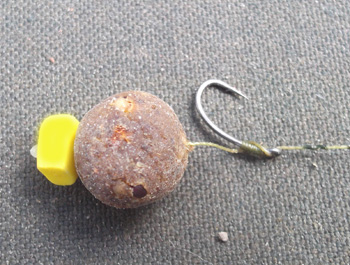 My hookbaits are small boilies tipped with plastic corn; any good quality boilie will do but I like to make it ‘zing’ a little to make it stand out and I do this by dunking them in various oils, flavours and glugs. The idea is that any feeding fish will be able to smell the hookbait over the ‘noise’ of the rest of the feed.
My hookbaits are small boilies tipped with plastic corn; any good quality boilie will do but I like to make it ‘zing’ a little to make it stand out and I do this by dunking them in various oils, flavours and glugs. The idea is that any feeding fish will be able to smell the hookbait over the ‘noise’ of the rest of the feed.
When it comes to actually putting the feed in I use two different methods: the catapult and the Spomb (more on that in a sec). I am not trying to create a pile of groundbait but a blanket so the balls I fire out are fairly small – about egg sized. It takes more work to make them up but the advantage is I can spread them around the chosen feature more. Some go long, some to the left and right and with some I try to hit the marker; what I want to create is an area about the size of an average bedroom with between 80 to 150 balls on it each evening.
By baiting like this I am aiming to get the fish grazing in the swim and working hard to get to the food and this means they are more likely to come across a bait with a hook attached!
A few years ago I met a couple of chaps who had perfected a way of literally spraying the bait out: they used a modified plastic wine glass and a piece of bicycle inner tube (I shall leave that as a point of mystery for you to work out). It was amazing to watch and created a patch of evenly spread bait rather than neat little piles. Needless to say, I went away and made one which I promptly broke within two casts leaving me looking for another way of spreading bait about – hence the reliance now on smaller balls of groundbait. [The ‘chaps’ are friends of mine Eddy and the method they invented is superb for creating the beds of feed you refer to – but it does take a bit of practise to make the device!]
The Spomb comes into play at night; if you do not know what one is, I won’t go into exact detail here but Google it and have a look, you will be confused at first, then impressed, then fall in love when you try it. The reason they are useful for this style of fishing is that, unlike normal spods, they can deposit a ball of ground bait intact and do not suffer from any spillage from the back. They are prefect if you need to top up the swim without using the catapult so when it’s after dark, or the marker is out of the water, you can still feed the swim easily and efficiently.
Tackle and Rigs
As I said earlier you do not need specialist tackle for big bream. Rod wise, although you can buy specialist bream and tench rods, any standard carp rod with a test of around 2.5lb or thereabouts should do. You can use barbel rods but bear in mind that you will be casting big old feeders and there is more than a possibility that a right old lump of a carp will turn up. I know from personal experience going light can leave you seriously undergunned if, like me, you hook a large catfish at 4am… Again your normal carp reels will do; load them with 10-12lb line and that’s about it.
I suspect the end rigs that work well are pretty much the same as any normal carp rig and for me that is a weighted leader or equivalent to pin things down and help prevent liners, a lead clip and a simple hair rig. However, I like to fish a method ball and as a result I looked for ways I could fish one whilst still keeping the line well out the way on bottom.
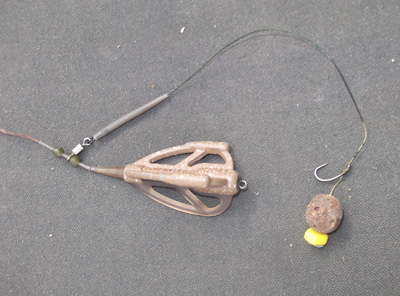 With a little research, some interesting conversations and a lot of experimentation I came up with a helicopter rig I’m more than happy with:
With a little research, some interesting conversations and a lot of experimentation I came up with a helicopter rig I’m more than happy with:
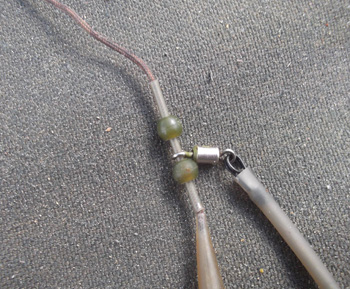 I use a small piece of shrink tube just above the feeder, on which the beads sit. This is a brilliant little tip I got from a carp lad a years back and it means the rig is very safe whilst still doing what you want it to. By moistening it before you push it on, one little shake and the top bead comes free really easily. It means if your main line does break the fish can shed the feeder in a flash. It works way better than those nasty little bits of silicon shop bought rigs come with.
I use a small piece of shrink tube just above the feeder, on which the beads sit. This is a brilliant little tip I got from a carp lad a years back and it means the rig is very safe whilst still doing what you want it to. By moistening it before you push it on, one little shake and the top bead comes free really easily. It means if your main line does break the fish can shed the feeder in a flash. It works way better than those nasty little bits of silicon shop bought rigs come with.
At the business end I use a curve shank size 9 hook with no tubing or rings or any of the other junk that seems fashionable today – this works brilliantly so why bother with the rest?
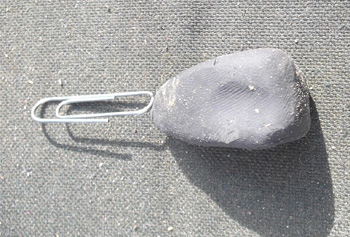 This is one of my cheapskate inventions! Back leads are hugely important to cut down liners but I feel aggrieved paying £5 for a pack of three when they invariably fall apart during a fight. I make mine out of a paper clip, some old line and a lump of Plasticine. Simple, stupidly cheap (£4 will get you a massive lump of Plasticine and hundreds of paper clips!). What is more, I reckon they work better than the ones from the shop – sorry Mr Fairbrass but it’s true!
This is one of my cheapskate inventions! Back leads are hugely important to cut down liners but I feel aggrieved paying £5 for a pack of three when they invariably fall apart during a fight. I make mine out of a paper clip, some old line and a lump of Plasticine. Simple, stupidly cheap (£4 will get you a massive lump of Plasticine and hundreds of paper clips!). What is more, I reckon they work better than the ones from the shop – sorry Mr Fairbrass but it’s true!
For my own sanity I only ever fish two rods for bream. This is mainly down to the size of the features I fish as three rods on one gravel patch is asking for trouble – not least trying to cast at it in the middle of the night but also because the more lines in the water the more you are likely to spook the fish. Handily, this leaves the option to fish a carp or catfish rod down the margins, which always adds a little spice to the evening when it screams off!
To be sure of distance after dark I take a leaf out of the carp boys’ books and use the line clip and electrical tape trick. It also pays dividends to really pay attention to what is on the opposite bank and what far bank markers you are using. No point picking a marker that you cannot see after dark, so pick something obvious like a tall tree and work out where you need to cast from there. As my casting can go a little astray when I am tired (I’m quite often ‘tired’ it seems), I also make sure I stand in exactly the same spot to cast each time. I do this by making a note of what is by my feet on the ground. Like a plonker, I once went to the point of marking it out in chalk, only for it to rain and wash it all away – one of my less successful ideas, but one that worked in theory.
Bream tend not to tear off with your bait and give you a screamer and the bites are, for the most part, a couple of beeps then a drop back. I tend to wait for the next indication before I lift in for two reasons: firstly to make sure it is not a liner and secondly I am quite often asleep for the first bit… For the most part though, if you are fishing a weighted leader and a back lead a beep is a bite, so worth a look.
One last tip is to take a barbel-sized pan net with you as well as your specimen net. This makes life a hell of lot easier netting and releasing any smaller bream and also means your big net doesn’t utterly stink by the end of the session.
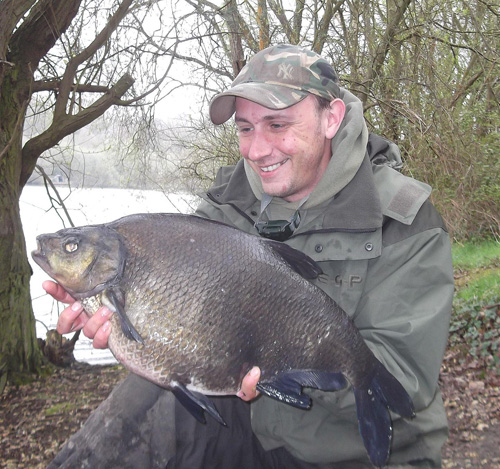 So there we have it – one long ‘how to’ piece. I always worry about writing these as they can often be very involved and not actually that interesting – especially one about bream fishing!
So there we have it – one long ‘how to’ piece. I always worry about writing these as they can often be very involved and not actually that interesting – especially one about bream fishing!
As I said before, despite fishing for almost every other fish species throughout the year, it is the sessions after bream that I think about the most. Maybe it is the amount of planning that goes in them – just the making the groundbait is great fun. It could also be playing with a massive catapult or the satisfaction of seeing a hundred neat groundbait balls ready to go. Perhaps, it is watching the sunrise with a cuppa, or eating lukewarm boil-in-a-bag pasta under the stars. Who knows? And even though the fish are smelly, ugly and fight like a one-legged pacifist I love catching them!
Anyway, I hope have been able to inspire you to look at bream in a different light and maybe you can cannibalize some of these ideas into your own fishing. Big bream fishing is fascinating, thought provoking and most of all great fun and one thing I will guarantee you – a slab over 10lb is an impressive fish in anyone’s book – goodness only knows what a twenty looks like!










